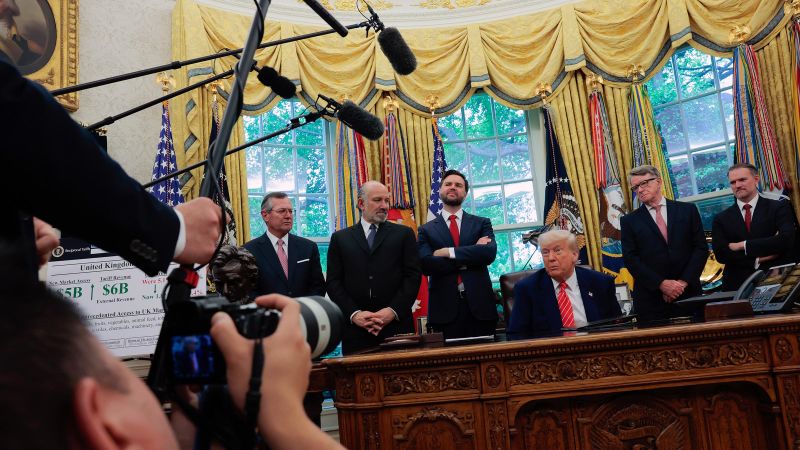A version of this story appeared in CNN Business’ Nightcap newsletter. To get it in your inbox, sign up for free here.
New York
CNN
—
OK, so! After a month of negotiations, we finally have a “full and comprehensive” trade agreement with our old pals across the pond.
Huge news! What a relief, right? Pop the champagne, the trade war nightmare is almost over…
What’s that? What’s in it, you ask? Like, what is the “deal” part of the deal?
OK, so it’s more of a concept of a deal. If a trade deal is, like, Michelangelo’s David, this is more like a block of marble. Or really it’s like a receipt from the marble guy that says we’ve placed an order for a block of marble.
Maybe put the champagne back in the fridge.
Here is what the US and the UK announced Thursday: President Donald Trump’s team took the US tax on British imports from 10% to *checks notes* 10%. Yes, it is the exact same tariff rate that Trump announced on April 2, but with some fun new carve-outs:
British cars: That Bentley you’ve had your eye on was going to be taxed at 27.5%, but now it’s only 10%. Great news for that sliver of Americans in the market for a Land Rover, Jaguar, Rolls-Royce or Aston Martin. No other consumer goods were mentioned.
Planes: British companies can now send plane parts to the US tariff-free. In return, British Airways is expected to order 30 Boeing 787 Dreamliner jets, according to Bloomberg.
Steel and aluminum: Taxes on steel and what the Brits call “aluminium” (adorable) will be scrapped.
Beef: Both countries get a bunch of tariff-free exports on commodities including beef and other agricultural products.
That’s honestly it — there are no more details, as both sides said specifics are still being ironed out. It’s not all that surprising, given that traditionally trade deals require months or even years of painstaking talks.
“A trade agreement where the details are still being negotiated is not an agreement,” said Joe Brusuelas, chief economist at RSM, on social media. “This does not provide the clarity necessary to lift the fog of uncertainty created by a trade war of choice.”
To hear the White House announce it on Thursday, though, you’d think they just won a Nobel prize and a gold medal. In a Truth Social post, Trump said it was “a very big and exciting day.”
UK Prime Minister Keir Starmer called it “historic” with what sounded like a straight face, though it should be noted he joined the Oval Office event via speakerphone, because the Trump administration cobbled this whole spectacle together at the last minute. (The British ambassador to the US even said that Trump called Starmer in a “very typical, 11th-hour intervention.”)
The Brits, for their part, said even an imperfect deal is better than no deal at all.
Asked by reporters in England whether this deal marks an improvement on the US-UK relationship of six months ago, before Trump took office, Starmer replied: “The question you should be asking is: Is it better than where we were yesterday?”
Which is a gentle British way of saying: Look, we’re all doing our little dances in the Trump show to avoid tempting the wrath of the leader of the world’s biggest economy.
Wall Street, similarly, isn’t letting perfection be the enemy of the good. Stocks rallied in the US as investors – hungry for any sign Trump is going to relent on the trade war – embraced the White House’s optimism.
Just for kicks, let’s say this is an actual framework for a real trade deal that will get hammered out over the next few weeks. That is better than nothing.
But it took more than a month to roll out this titanic nothingburger with one of our closest allies. An ally that, with all due affection to our British brethren, accounts for just 3% of all US trade, Justin Wolfers, professor of economics at the University of Michigan, told CNN.
That doesn’t bode well for the thousands of American businesses that are currently paralyzed by Trump’s 145% tariffs on most imports from China, an adversary that’s not so charmed by the president’s 11th-hour shenanigans and is America’s third-largest trading partner.
US and Chinese envoys are set to meet this weekend in Geneva. But American officials aren’t even suggesting a trade deal will come out of it – the best that US Treasury Secretary Scott Bessent said he’s hoping for is “de-escalation.”
Bottom line: Very little has changed about the state of the global economy since the US-UK “deal” was announced. We still have a 22% effective tariff rate today – the highest in more than 100 years – compared with 2.5% before Trump took office.
“Overwhelmingly the most important fact about today’s trade deal is that the 10% across the board tariffs are staying,” Wolfers said on social media Thursday. “Tiny tweaks here and there with some trading partners won’t change that. The US is a high tariff country for the foreseeable future, and the trade war continues.”

